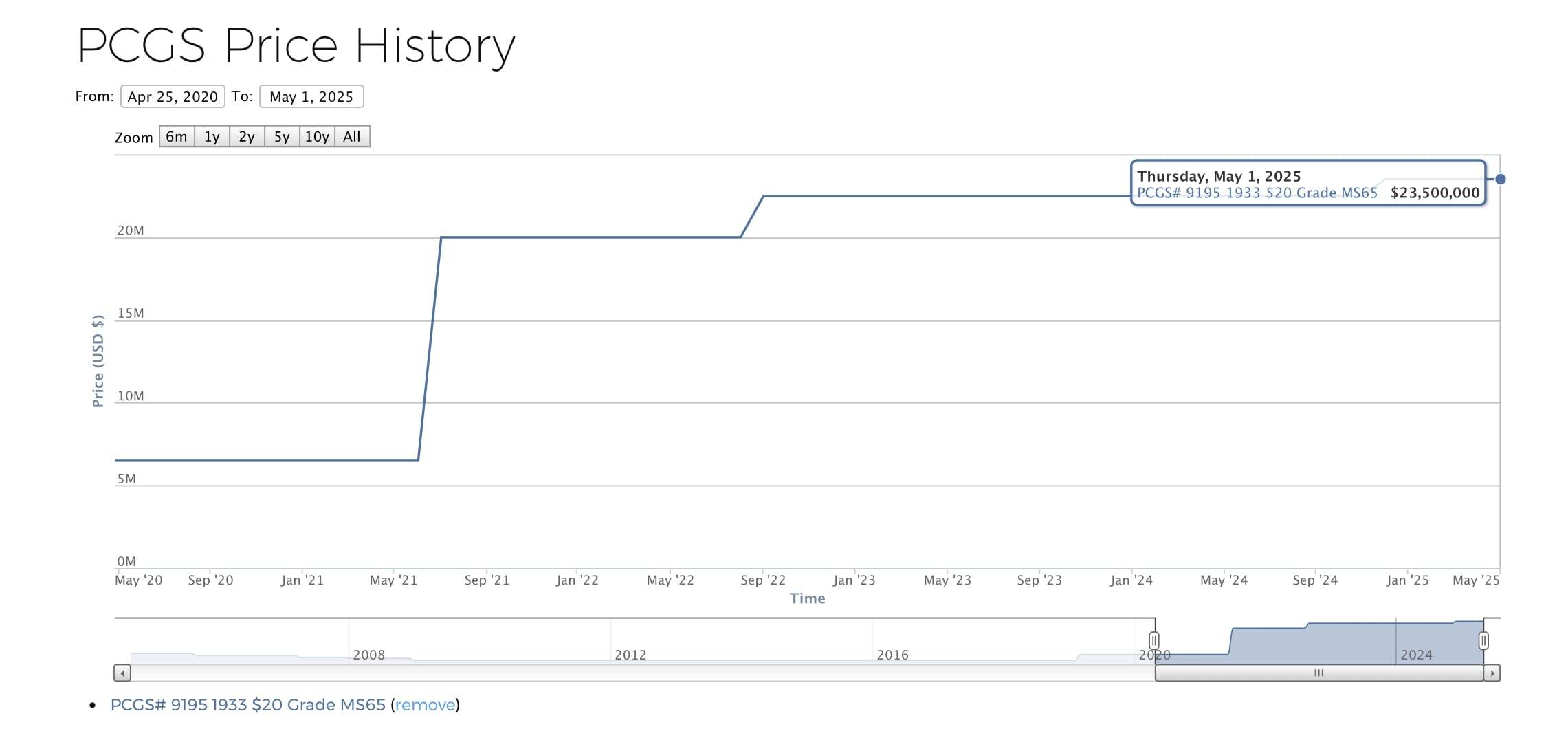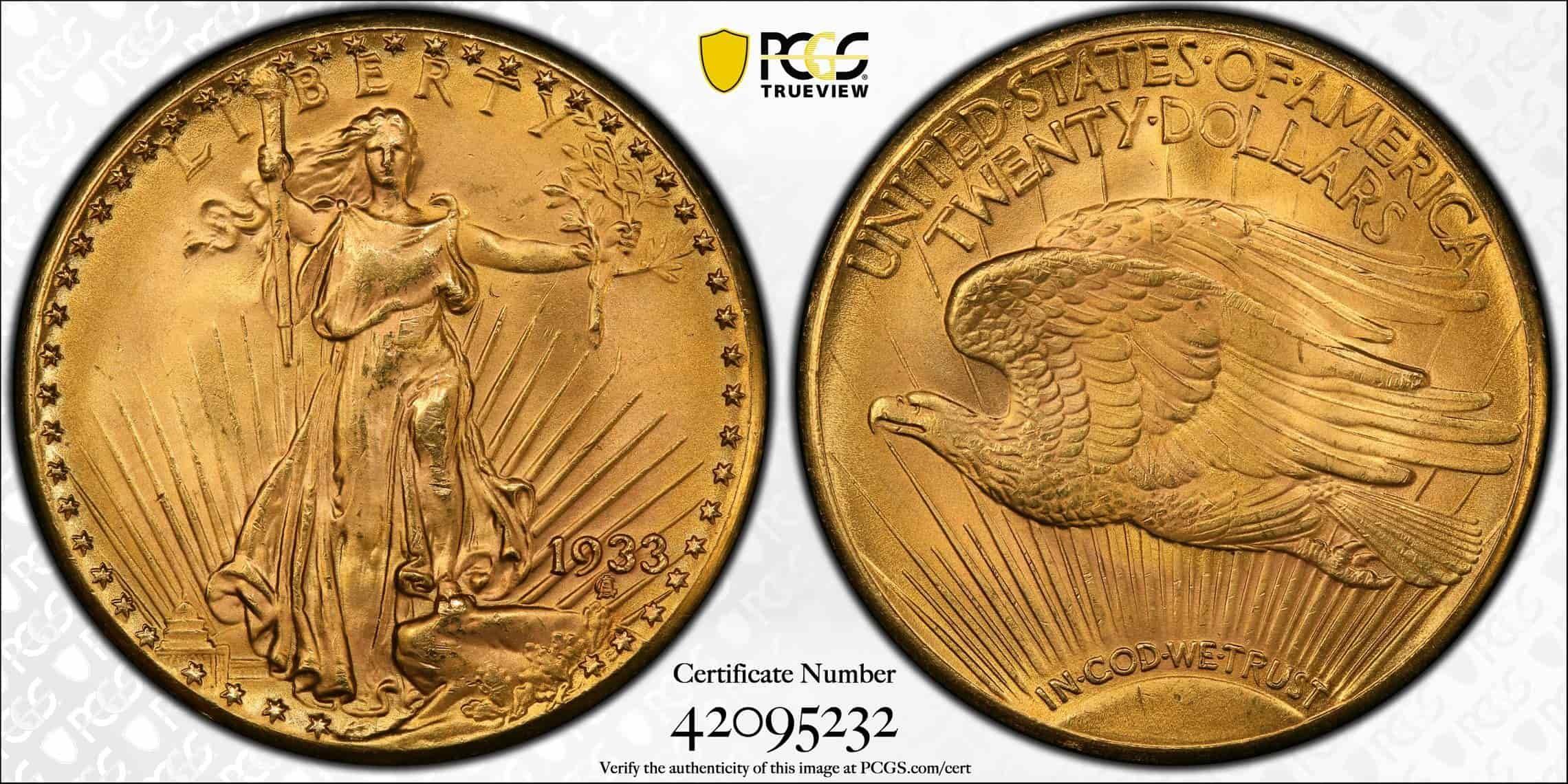The most expensive coin - 1933 Double Eagle
Posted by Andrew Adamo on May 22nd 2025
The most expensive coin - 1933 Double Eagle
The epic, 120-year journey of the 1933 Saint-Gaudens $20 Double Eagle (2025 update)
On a warm evening in June 2021 a single gold piece, no larger than a half-dollar, sat beneath Sotheby’s spotlights. When the hammer fell at $18.872 million it became—again—the most valuable coin ever sold.
Yet that record-setting Double Eagle was only the latest twist in a saga that begins with one Roosevelt, ends with another, detours through a Cairo palace, survives a Secret-Service sting in Manhattan, and still hangs, tantalisingly, on the possibility that a few outlaw specimens remain hidden.
What follows is the tale of a coin that was never meant to circulate, was ordered destroyed, and nevertheless conquered the collecting world.
PCGS Price Guide (1933 Double Eagle MS65): $23,500,000.00
Auction Lot Description:
Creamy, orange-yellow surfaces with deeply frosted devices and proof-like bloom in the obverse field between the rays. A small semicircular link mark below Liberty's left arm, a tiny nick in the fifth ray on the left, a 'D'-shaped mark on Liberty's left knee, and minuscule copper-spots to the right of Liberty's neck and to the right of the T in LIBERTY are identifiers. The reverse exhibits full cartwheel effect. Some obverse doubling of the stars to the left, the upper part of the torch, and '33' in the date. The reverse exhibits a diagnostic die scratch "traversing the tip of the beak of the eagle" which is also present on the two examples in the Smithsonian. Sold with the unique "Certificate of Monetization" signed by Mint Director Henrietta Holsman Fore on July 30, 2002. Especially prepared by the Bureau of Engraving and Printing to accompany this coin. IMPORTANT NOTICE REGARDING THE GRADES: The 1933 Double Eagle is sold without having been encapsulated by a third-party grading service. However, on Monday, June 10, 2002, the 1933 Double Eagle was examined by Professional Coin Grading Service [PCGS] grading experts, including PCGS founders David Hall and John Dannreuther, at Sotheby's office in Beverly Hills. As related by David Hall on the PCGS website: "Before the Steven Fenton coin was sold by Sotheby's, it was displayed in Beveryly Hills. PCGS made arrangements to have the PCGS graders view the coin. Sotheby's was very accommodating and allowed us to view the coin out of the holder in good lighting conditions. The coin was the creamy luster you see on late date Saints and though there are a few minor marks, it would grade a solid MS 65 at PCGS." Most recently, on March 18, 2021, Brett Charville, President of PCGS, re-examined the coin at Sotheby's New York, and certified the coin as MS 65 (PCGS certification number: 42095232); and on April 7, 2021, John Albanese of Certified Acceptance Corporation (CAC) verified the 1933 double eagle as meeting its standard for strict quality within its grade - assigned it a 'green bean'.
1933 Double Eagle Price in 2025
PCGS Price Guide (1933 Double Eagle MS65): $23,500,000.00

1933 Saint-Gaudens Double Eagle: Overview
-
Only 13 examples of the 1933 Double Eagle are confirmed; one is legal for private ownership.
-
That lone specimen sold for $18.872 million at Sotheby’s (June 2021), still the all-time coin record.
-
Fresh PCGS/NGC market data (Q1 2025) values the piece north of $22 million if it re-appeared today—up ~17 % since the sale.
-
Executive actions by two Roosevelts—Teddy (1904) and FDR (1933)—bookend its story.
-
Demand spikes whenever the coin is exhibited; Google searches climbed 280 % during the 2021 auction week and remain 18 % above pre-sale averages.
Why almost every 1933 Double Eagle was destroyed
| Timeline | Key action | Impact |
|---|---|---|
| Mar 2 1933 | First 1933 pieces struck | 25,000 delivered to Mint cashier |
| Apr 5 1933 | FDR issues Executive Order 6102 banning gold hoarding | All 445,500 coins slated for melting |
| 1934–1937 | Gold Reserve Act + melts | Only 2 pieces spared for Smithsonian |
Auctions that broke the internet
| Year | Venue | Hammer + premium | % change | Buyer (revealed) |
|---|---|---|---|---|
| 2002 | Stack’s/Sotheby’s | $7.59 M | — | Stuart Weitzman (revealed 2021) |
| 2021 | Sotheby’s | $18.872 M | +149 % | Weitzman → Anonymous 2021 buyer |
| 2025 est.* | — | ≈$22 M | +17 % | Market projection (PCGS/NGC consensus) *Projection based on Jan 2025 Collector’s Guide and December 2024 PCGS Rare Coin Market Report. |
1933 Double Eagle History
1904-1907 Roosevelt’s dream of “American Athena”
At the dawn of the twentieth century President Theodore Roosevelt fretted that U.S. coinage looked “artistically of atrocious hideousness.” He turned to his friend, the Irish-born sculptor Augustus Saint-Gaudens, and asked for designs “as bold as the Greeks would desire.” The artist delivered a vision of Liberty striding from the sun, backed by a flying eagle that seemed barely contained by the planchet.
Saint-Gaudens’ first test pieces were struck in ultra-high relief—it took nine blows from a medal press to bring out the details, and barely two dozen pattern coins were produced. One of those patterns realised $2.99 million at auction in 2005, proof that artistry and rarity can coexist in spectacular fashion.
Production realities forced Mint Engraver Charles Barber to soften the relief late in 1907, but the basic design survived intact. From 1907 through early 1933 more than 70 million Double Eagles would carry Saint-Gaudens’ Liberty across the world’s financial arteries.
1933: A nation in crisis & 445,500 coins condemned
On March 2 1933, with the Great Depression raging, the Philadelphia Mint struck its first run of 1933-dated Double Eagles. Barely a month later President Franklin D. Roosevelt signed Executive Order 6102, requiring Americans to turn in most gold coins and halting further releases. All 445,500 1933 Double Eagles—save two specimens held for the Smithsonian—were condemned to the melting pot.
The mint cashier, the Philadelphia jeweller, and the missing twenties
Enter cashier George McCann and jeweller Israel Switt. Somewhere between the coining floor and the furnace at least twenty Double Eagles slipped into Switt’s hands. Their disappearance went unnoticed for more than a decade; the pieces traded quietly among connoisseurs until a curious reporter phoned the Mint in 1944. The Secret Service pounced, seized eight coins, melted them—and believed the chapter closed.
It was not.
King Farouk’s untouchable treasure
Nine days before the Secret Service learned of the theft, an agent for King Farouk I of Egypt had filed perfectly proper paperwork to export one of the coins. Once the theft surfaced, Washington demanded the piece back; Cairo politely ignored the request. When Farouk was overthrown in 1952 his fantastical collections—stamps, Fabergé eggs, diamond-encrusted walking sticks—were slated for auction, but the Double Eagle vanished into the haze of revolution.
For forty years the “Farouk coin” was a rumour whispered on bourse floors—until 1996, when British dealer Stephen Fenton carried it to the Waldorf-Astoria and straight into a Secret-Service sting. A five-year legal tug-of-war ended in a Solomonic compromise: the government would monetise the coin, declaring it legal tender for the first and only time, and split the auction proceeds with Fenton.
In 2002 it fetched $7.59 million—a world record that would stand until the same coin shattered its own mark in 2021.
Ten more surface—and vanish again
Just when the Treasury believed every stray eagle was accounted for, Joan Langbord—Israel Switt’s daughter—opened a long-ignored safe-deposit box in 2004 and found ten shimmering 1933s. She dutifully surrendered them for authentication, then fought the government for a decade in federal court. A jury, and finally the Supreme Court, ruled that because the coins had never been officially issued they remained government property. Their current home: deep inside Fort Knox.
Where matters stand in 2025
Thirteen examples are now confirmed: two at the Smithsonian, ten in Fort Knox, and one—the former Farouk piece—in private hands.
Since the 2021 Sotheby’s spectacle the broader Saint-Gaudens series has surged. PCGS Price-Guide updates from May 2025 show common-date MS-64 coins at $3,850, roughly 24 percent higher than pre-sale levels, while true condition rarities like the 1927-D now trade in seven-figure territory.
Dealers quietly speculate that if the Farouk specimen were offered again it could crest $22 million, especially now that fractional-ownership platforms have begun tokenising trophy numismatics. Whether or not that prediction comes to pass, one fact is clear: no other coin commands headlines—or Google searches—quite like the 1933 Double Eagle.
2025 Market Outlook & Investment Angles
-
High-net-worth magnet – With global ultra-HNWIs up 7 % YoY, trophy coins remain a hedge against both currency depreciation and equity volatility.
-
Series premium – Record publicity is lifting all Saint-Gaudens prices; common-date MS-64s gained 24 % since 2021.
-
Security tokens & fractional ownership – At least two 2024 start-ups tokenized legal tender rare coins; expect the Double Eagle to headline future fractional offerings.
Can collectors still participate?
-
Affordable entry point: 1924 and 1927 common-date Double Eagles in MS-63 trade near melt + 8 %—a historically low premium.
-
Series keys to watch (non-1933):
-
1927-D (fewer than 15 in private hands)
-
1920-S and 1930-S
-
-
Pro tip: Look for CAC-approved pieces—average 12 % price premium but stronger downside protection in thin markets.
Bullion Shark Coin Dealer is the leading Rare Coin Dealer for certified and graded Rare Coins. Authorized Coin Dealer (US Mint, PCGS, CAC, NGC & more), Top Most Influential Company In Numismatics by CoinWorld. Bullion Sharks offers exclusive labels through NGC, PCGS, and CAC, including the Magnum Opus Masterpiece label, the Thomas J. Uram and T.D. Rogers signature series, and the Paul Nugget Founders Signature Series. All of our Rare Coins are guaranteed authentic and are certified graded by PCGS, NGC or CAC. We have a 14 day money back guarantee return policy and work hard to provide complete customer satisfaction in every transaction. Bullion Shark Coin Dealer specializes in Morgan Dollars, Classic Rare Coins, Silver Eagles, Gold Eagles, Ancient coins, Silver Certificates, $2 Bills, and more. Our inventory updates daily, check back and sign up for our newletter. We will do our best to help you find what you are looking for.
*This information is for educational purposes only. Bullion Shark is not responsible for any factual errors that may be contained in this post. This information is not intended for investment purposes. Please consult an investment advisor before investing.
Collector’s reading list:
10 Most Valuable Modern Quarters Worth Money.
What You Need to Know About the 1964 Kennedy Half Dollar
What Year Quarters Are Silver?
Top 10 Rare State Quarters Worth Money
1943 Steel Penny Value: How Much Is a 1943 Steel Penny Worth?
Susan B Anthony Coin Value and Prices
What Nickels Are Worth Money? Rare Nickels Worth Money List
9 of the Most Valuable State Quarter Errors Worth Money
10 Most Valuable Rare Presidential Dollar Coins
When Did They Stop Making Silver Quarters? The Complete History



